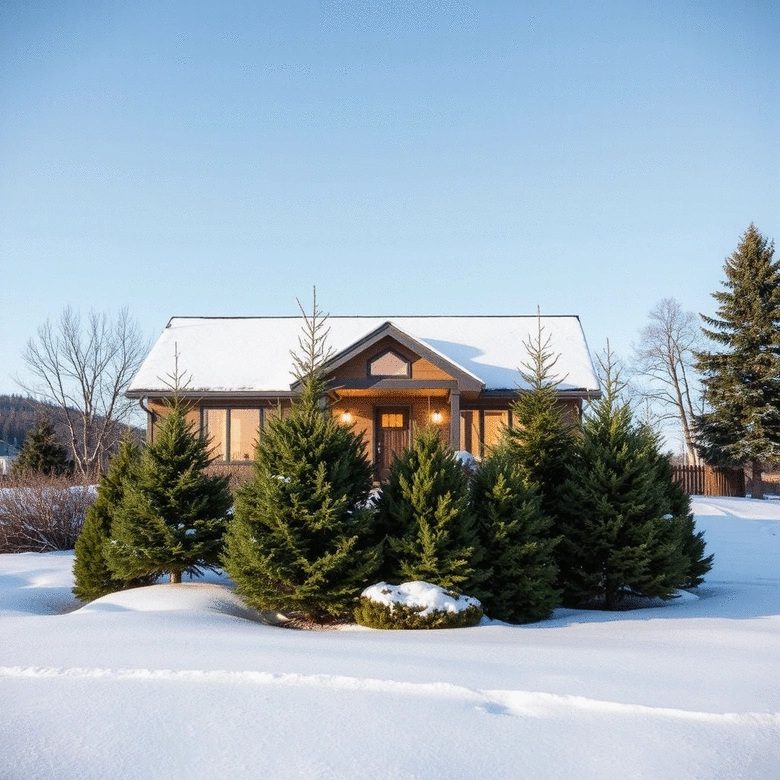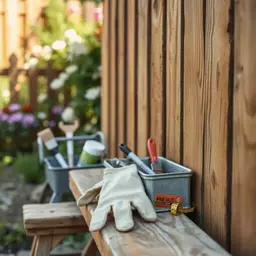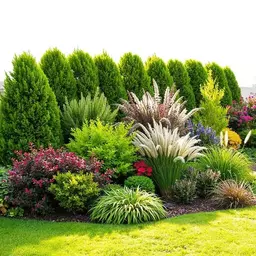Windbreaks: Save on Heating Costs
Windbreaks are more than just rows of trees; they are strategic investments that can transform your home’s energy efficiency. Learn how these natural barriers not only beautify your landscape but also enhance your comfort and reduce heating costs, making them an indispensable feature of any property.
What You Will Learn
- Windbreaks significantly reduce heating costs by decreasing wind speed and trapping heat around your home.
- They create beneficial microclimates that extend the growing season for plants and improve comfort during outdoor activities.
- Regular maintenance, including pruning and watering, is essential to keep windbreaks healthy and effective.
- Integrating windbreaks with modern energy solutions, such as insulation and smart technology, enhances overall home comfort.
- Sustainable landscaping practices, like using native plants and organic methods, contribute to a healthier environment while maintaining your windbreaks.
Impact of Windbreaks on Heating Costs
Windbreaks significantly reduce energy costs by creating beneficial microclimates and lowering heating needs. Below is a visual representation of their effects on heating efficiency.
Decrease in Wind Speed
Windbreaks reduce wind speed, which decreases cold air entering your home, leading to lower heating costs.
Heat Trapping Barrier
Windbreaks create barriers that trap heat, maintaining a warmer temperature in the sheltered area.
Reduction in Heating Costs
By effectively combining windbreaks with insulation, homeowners can significantly reduce their heating expenses.
Creation of Microclimates
Windbreaks contribute to the formation of microclimates, allowing for extended growing seasons and improved outdoor comfort.
Understanding the Impact of Windbreaks on Heating Costs
Windbreaks are a fantastic addition to any property, especially when it comes to managing heating costs. By strategically placing trees and shrubs around your home, you can significantly reduce the amount of energy needed to keep your space warm during the colder months. At Branch & Border, I often emphasize the importance of these natural barriers in creating both beauty and functionality in outdoor spaces. For more insights on choosing the right plants, check out our guide on trees for effective windbreaks.
Defining Windbreaks and Their Purpose
What Are Windbreaks?
Simply put, windbreaks are rows of trees or shrubs planted to protect areas from the wind. They serve multiple purposes, from providing privacy to improving energy efficiency. Think about it: instead of a stark fence, a vibrant wall of greenery not only enhances the aesthetics but also acts as a natural shield!
Windbreaks can be made up of various plants, but evergreens are particularly popular due to their year-round foliage. These plants can absorb wind and reduce its speed, creating a calm microenvironment around your home. This allows for a cozy retreat, making outdoor activities more enjoyable even on blustery days.
How Windbreaks Function in Climate Control
Windbreaks play a crucial role in climate control by altering local weather conditions. They can raise the temperature in the sheltered area, making it possible for homeowners to feel comfortable without cranking up the heat. Here are a few ways windbreaks can help:
- Decrease wind speed, which leads to less cold air entering your home.
- Create a barrier that traps heat, keeping your space warmer.
- Reduce heating costs by cutting down on the energy needed to maintain a comfortable temperature.
By carefully selecting the types of trees and shrubs for your windbreak, you can enjoy a significant impact on your home's heating efficiency. Plus, it adds a natural charm to your landscape! For ideas on landscaping for privacy screens, which often double as windbreaks, explore our resources.
The Role of Microclimates in Heating Efficiency
How Windbreaks Create Beneficial Microclimates
Microclimates are small areas where the climate differs from the surrounding areas, and windbreaks are key players in creating these pockets of comfort. When trees and shrubs are strategically planted, they can help trap warmth and create a haven for plants and even people! This is especially important during the colder months.
Some of the benefits of these microclimates include:
- Extended growing seasons for plants.
- Improved comfort for outdoor activities.
- Reduced need for heating inside your home.
At Branch & Border, I love helping clients design landscapes that not only look good but also function effectively to enhance their living conditions. By considering how windbreaks can create microclimates, homeowners can make informed decisions that lead to greater energy efficiency.
Pro Tip
Did you know? The orientation of your windbreak can significantly impact its effectiveness. Ideally, plant your windbreak at an angle of 30 to 45 degrees to the prevailing winds. This positioning maximizes wind deflection and helps create a warmer microclimate around your home, ultimately leading to greater energy savings!
Addressing Common Questions About Windbreaks
As a landscape designer, I often hear questions about the long-term care and maintenance of windbreaks. It's crucial to understand that while windbreaks can offer fantastic benefits, they do require some attention to keep them thriving. Let’s delve into what it takes to maintain these living shields effectively!
First, regular maintenance can help ensure that your windbreak continues to perform well over the years. Here are key aspects to consider:
- Pruning: Regular pruning helps maintain the shape and health of your trees and shrubs.
- Watering: Newly planted windbreaks may require extra water, especially during dry spells.
- Fertilizing: A gentle fertilizer application can promote healthy growth.
What Maintenance Is Required for Windbreaks?
Maintaining windbreaks is not just about aesthetic upkeep; it's about ensuring they function effectively. Seasonal changes can impact their performance, and you'll want to monitor them regularly to see how they adapt. Here are some maintenance practices to keep in mind:
- Inspect for Pests: Regular checks for pests can prevent infestations that may harm your plants.
- Mulching: Applying mulch can help retain moisture and suppress weeds.
- Seasonal Care: Each season poses different challenges—be ready for snow loads in winter and drafts in autumn.
Long-term Care and Cost Considerations
Maintaining your windbreak can be a rewarding investment. By keeping them healthy, you ensure they continue to provide the benefits of reduced heating costs and increased privacy. Plus, you’ll enjoy a beautiful landscape year-round! The cost of maintenance can vary depending on your approach, but it’s often far less than the savings on heating bills. For more information on managing costs, consider visiting a comprehensive guide on effective landscape cost management.
When you think about investing in windbreaks, consider how much you might save in heating costs. For example, you might find that spending a little on maintenance translates into significant energy savings over time!
Integrating Windbreaks with Modern Energy Solutions
As homeowners look to modernize their energy solutions, integrating windbreaks into the mix is a smart move. Pairing these natural barriers with energy-efficient practices enhances your overall home comfort. Here are some ways to do this:
- Combine with Insulation: Ensure your home is well-insulated to maximize the benefits of your windbreaks.
- Use Smart Thermostats: Invest in smart technology that takes advantage of natural heating and cooling.
- Encourage Natural Light: Position your windbreaks to not only block the wind but also allow sunlight to warm your home in winter.
Combining Windbreaks with Home Insulation Techniques
By using insulation techniques alongside your windbreaks, you can achieve a harmonious balance between energy efficiency and comfort. Think about how the right trees and shrubs can complement your insulation efforts, creating a cozy atmosphere during colder months. This synergy can lead to a more energy-efficient home—something I’ve seen work wonders for many of my clients at Branch & Border.
The Role of Sustainable Practices in Windbreak Design
At Branch & Border, I believe in sustainable landscaping practices that benefit both the homeowner and the environment. Implementing eco-friendly techniques in your windbreak design not only helps your property but also contributes to a healthier planet. Here are some sustainable practices you can incorporate:
- Native Plant Selection: Choose native species that require less water and maintenance.
- Organic Methods: Use organic fertilizers and pest control to minimize chemical impact.
- Permaculture Techniques: Design your windbreak to support biodiversity and natural ecosystems.
Implementing Eco-friendly Landscaping Techniques
By integrating sustainable practices, you’re not just enhancing your property; you’re also preserving resources for future generations. It’s a win-win! As you consider your windbreaks, think about the broader impact they can have on your local environment. You’ll find that a little effort can go a long way towards making a big difference. For effective strategies on using native plants for windbreaks and privacy, explore our detailed guide.
Concluding Insights on Windbreaks and Heating Efficiency
Windbreaks are truly remarkable when it comes to energy savings and enhancing your outdoor space. By addressing common questions and emphasizing care, we can appreciate the numerous benefits they offer. I encourage you to consider how windbreaks can transform your property and save you money on heating!
As you explore the possibilities of integrating windbreaks into your landscape, I invite you to reach out to me at Branch & Border. Together, we can create a design that meets your needs while promoting sustainability and efficiency. Let’s make your outdoor space a sanctuary that not only looks good but also feels good! Explore local resources and expert guidance to get started on this exciting journey toward a more energy-efficient home. You might also find valuable information on building dense shrub windbreaks for maximum effectiveness.
Recap of Key Points
Here is a quick recap of the important points discussed in the article:
- Understanding Windbreaks: Windbreaks are rows of trees and shrubs that protect areas from wind, enhancing energy efficiency and aesthetics.
- Benefits of Windbreaks: They decrease wind speed, trap heat, and significantly reduce heating costs during colder months.
- Creating Microclimates: Windbreaks lead to beneficial microclimates, extending growing seasons and improving outdoor comfort.
- Maintenance Matters: Regular maintenance, including pruning, watering, and pest management, is crucial for the long-term effectiveness of windbreaks.
- Combining with Modern Solutions: Integrating windbreaks with insulation and smart home technology enhances overall energy efficiency.
- Sustainable Practices: Use native plants and organic methods in your windbreak design to promote environmental health.
Frequently Asked Questions About Windbreaks
1. How do windbreaks reduce heating costs?
Windbreaks reduce heating costs by decreasing wind speed around your home, which minimizes cold air infiltration. They also create a barrier that traps heat, maintaining a warmer temperature in the sheltered area and reducing the energy needed to heat your home.
2. What are microclimates, and how do windbreaks create them?
Microclimates are small, localized areas with different climatic conditions than the surrounding region. Windbreaks create beneficial microclimates by altering wind patterns and trapping solar radiation, leading to warmer temperatures, extended growing seasons for plants, and improved comfort for outdoor activities.
3. What kind of maintenance do windbreaks require?
Windbreaks require regular maintenance including pruning to maintain shape and health, consistent watering, especially for newly planted trees and during dry spells, and occasional fertilizing to promote healthy growth. It's also important to inspect for pests and apply mulch to retain moisture and suppress weeds.
4. Can windbreaks be integrated with modern energy solutions?
Yes, windbreaks can be effectively integrated with modern energy solutions. Combining them with proper home insulation techniques amplifies energy savings. Utilizing smart thermostats can further optimize heating and cooling, taking advantage of the natural temperature regulation provided by windbreaks. Positioning them to allow natural light can also help warm your home in winter.
5. What are sustainable practices for windbreak design?
Sustainable practices for windbreak design include selecting native plant species that require less water and maintenance, using organic methods for fertilization and pest control to minimize chemical impact, and incorporating permaculture techniques to support biodiversity and natural ecosystems. These practices benefit both the homeowner and the environment.






